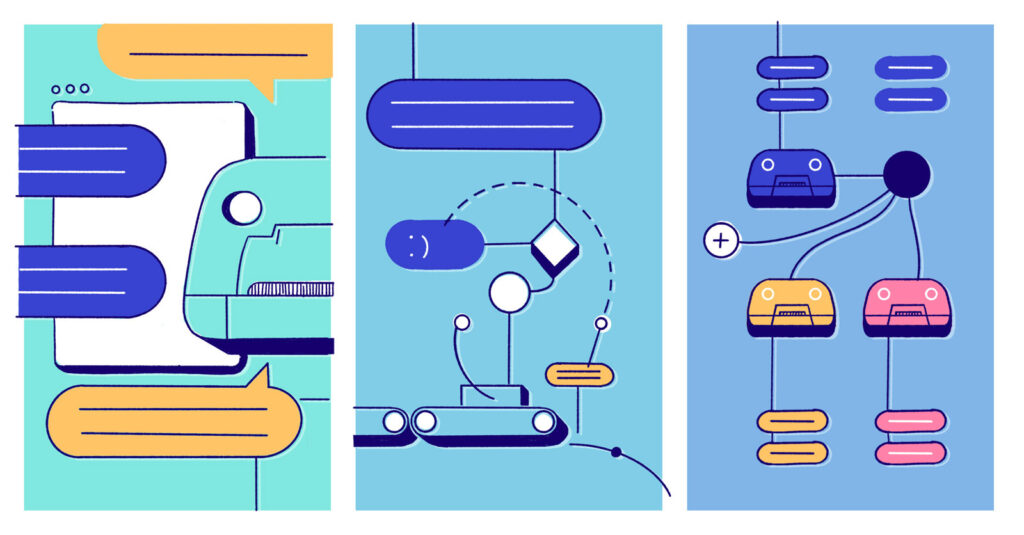AI and machine learning are transforming the way businesses operate around the world. In fact, Gartner found that 37% of enterprises across all industries are now using AI, which is a giant leap from 10% in 2015. As businesses continue to shift their focus to the customer experience, applications of AI to the Service client space will only continue to grow.
In this post, we’ll look into some examples of those applications:
the difference between autonomous and augmented AI solutions
how AI is used in customer service
how you can enhance your customer support efforts using an AI-powered language platform.
Replacing vs. augmenting human customer service
Intelligence exists on a continuum: Some AI-based solutions may fully replace manual tasks, while others assist humans in achieving greater outcomes. In general, AI and machine learning fall under two categories: autonomous and augmented solutions. Here’s a breakdown of each type.
Autonomous AI-based solutions leverage machine learning algorithms to operate tasks or processes, independently of humans. For example, real-time chatbots can communicate with customers without the need for a customer service agent. The challenge with autonomous solutions is that they’re often not on par with humans yet in terms of natural language processing and contextual decision-making. Such activities are often complemented with human supervision.
Augmented AI-based solutions leverage data and algorithms to support human decision-making and enable people to do things they wouldn’t be able to do on their own. Examples of augmented AI-based solutions in customer service include researching answers to customer inquiries to reduce response times and using predictive insights to provide agents with relevant information that drives stronger customer relationships.
How is AI used in customer service?
There are a variety of ways that AI is currently being used in customer service — from automated messages to live chatbots and machine translations. Here are three ways companies are using AI in customer service today.
Live chatbots
Live chatbots were one of the earliest and most widely implemented uses of AI in the customer service space. Initially, companies envisioned live support chatbots replacing many of their human support personnel, but automated bots on their own often led to frustrated customers and a lack of human connection.
The most effective implementations of chatbots allow customers to start an interaction with the bot and successfully hand off the conversation to a human agent once the problem is scoped or the resolution outlook is more complex. This enables live chatbots to handle low-level customer inquiries so that customer service agents can focus on resolving issues that require human reasoning and customer empathy.
Contact center automation
Many companies are using AI and machine learning to optimize their business processes. For example, contact centers often use software to assign customer service agents to relevant customer inquiries. Using AI, customer service teams can automatically match customer service agents to issues that fit their particular skill sets using behavioral data.
In addition, many companies use AI and machine learning to better understand their customers and generate automated messages. Automating these types of tasks eliminates busywork, so customer service agents can focus on more complex customer issues. These AI-powered processes, therefore, allow companies to more efficiently utilize the unique skills of their customer service agents to offer a better customer experience.
Machine translation
Machine translation has come a long way, helping customer service teams scale to offer support in additional languages without hiring native-speaking agents. That said, the best implementations of machine translation for multilingual support leverage human oversight to accurately capture the company’s tone of voice and industry expertise during customer interactions.
Moreover, augmented machine translation allows organizations to expand to additional languages that wouldn’t be feasible with native-speaking agents alone, without compromising on quality. Augmented machine translation also enables companies to forge stronger connections with a global customer base and leverage language beyond the customer service department. This streamlined approach to translating customer communication across the organization is called Language Operations.
Taking your customer service to the next level with AI translation
Looking towards the future, Gartner has predicted that 70% of customer interactions will involve emerging technologies like machine learning, chatbots, and more by 2022. We believe augmented machine translation, in particular, will see enormous growth as more and more companies target global customer bases and need to communicate in multiple languages.
There’s no doubt that language is an essential part of empathetic communication. In fact, studies have shown that speaking to someone in their native language elicits a strong emotional response, meaning it’s one of the best ways to build customer trust and loyalty. But machine translations on their own often lack the linguistic and cultural nuances to authentically communicate with customers.
An AI-powered Language Operations platform like Unbabel can provide high-quality, authentic translations at scale. Unbabel leverages human editors to refine machine translations, improving the quality of current and future translations. This enables organizations to scale their multilingual customer support efforts and transform language into a strategic asset for their business.












